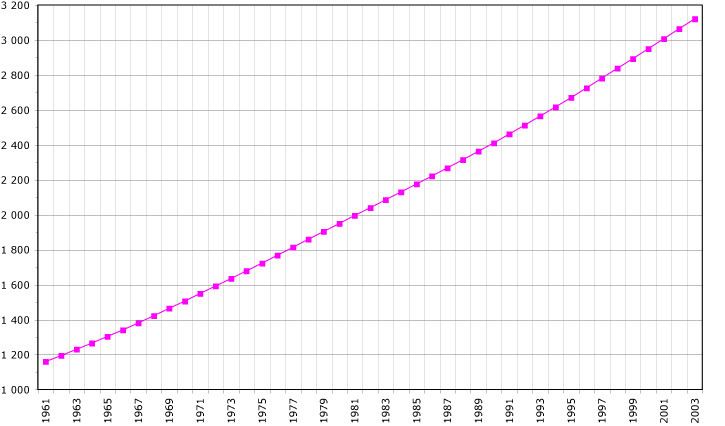 | ||
This article is about the demographic features of the population of Panama, including population density, ethnicity, education level, health of the populace, economic status, religious affiliations and other aspects of the population.
Contents
- Map of Panama
- Population
- Structure of the population
- Population distribution
- Ethnic groups
- Chinese
- African Panamanians
- Languages
- Religion
- Vital statistics
- References
Map of Panama
Population
Panama's population was 3,678,000 in 2010, compared to 860,000 in 1950. The proportion of the population aged below 15 in 2010 was 29%. 64.5% of the population were aged between 15 and 65, with 6.6% of the population being 65 years or older.
Structure of the population
Structure of the population (01.07.2013) (Estimates - Data refer to projections based on the 2010 Population Census):
Population distribution
More than half the population lives in the Panama City-Colón metropolitan corridor.
Ethnic groups
The culture, customs, and language of Panama are predominantly Caribbean Spanish. In 2010 the population was 65% Mestizo (mixed white, Native American), 9.2% Black, 6.8% mulattoes, 13% White and 6% Native Americans.
Ethnic groups in Panama include Spanish British and Irish, Dutch, French, Germans, Italians, Portuguese, Poles, Russians or Ukrainians (a large number are Jews), and Americans.
Afro-Panamanian groups include West Indies/Caribbean (esp. Afro-Caribbean) nationalities, in which thousands of Barbadian and Jamaican workers played a role in the construction of the Panama Canal. During the Atlantic Slave Trade, thousands of West Africans were transported to various places in Panama. This took place around the 1500s, making half of all Panamanians contain African ancestry. There has also been immigration of Arabs and Asians: in particular Chinese, Lebanese, Palestinians, South Asians (from India and Pakistan) and Syrians.
Chinese
Panama has a considerable populations of Chinese origin. The first Chinese immigrated to Panama from southern China to help build the Panama Railroad in the 19th century. There followed several waves of immigrants whose descendants number around 50,000. Starting in the 1970s, a further 80,000 have immigrated from various parts of China. Most of the Chinese population reside in the province of Chiriquí.
African Panamanians
Afro-Panamanians first arrived during the colonial era. They are intermixed in the general population or live in small Afro-Panamanian communities along the Atlantic Coast and in villages within the Darién jungle. Most of the people in Darien are fishermen or small-scale farmers growing crops such as bananas, rice and coffee as well as raising livestock. Other Afro-Panamanians descend from later migrants from the Caribbean who came to work on railroad-construction projects, commercial agricultural enterprises, and (especially) the canal. Important Afro-Caribbean community areas include towns and cities such as Colón, Cristobal and Balboa, in the former Canal Zone, as well as the Río Abajo area of Panama City. Another region with a large Afro-Caribbean population is the province of Bocas del Toro on the Caribbean coast just south of Costa Rica.
Most of the Panamanian population of West Indian descent owe their presence in the country to the monumental efforts to build the Panama Canal in the late 19th and early 20th centuries. Three-quarters of the 50,000 workers who built the canal were Afro Caribbean migrants from the British West Indies. Thousands of Afro-Caribbean workers were recruited from Jamaica, Barbados and Trinidad.
Languages
Many languages, including seven indigenous languages, are spoken in Panama, although Spanish is the official and dominant language. English is sometimes spoken by many professionals and those working in the business or governmental sectors of society.
Religion
The majority of Panamanians are Christian; most are Roman Catholics as a result centuries of Spanish colonial influence. Other faiths exist in Panama by the country's tolerance and freedom of religion, there are large Protestant, Jewish, Bahá'í, Muslim and Hindu religious groups in Panama.
Vital statistics
Registration of vital events is in Panama not complete. The Population Departement of the United Nations prepared the following estimates.
Births and deaths
